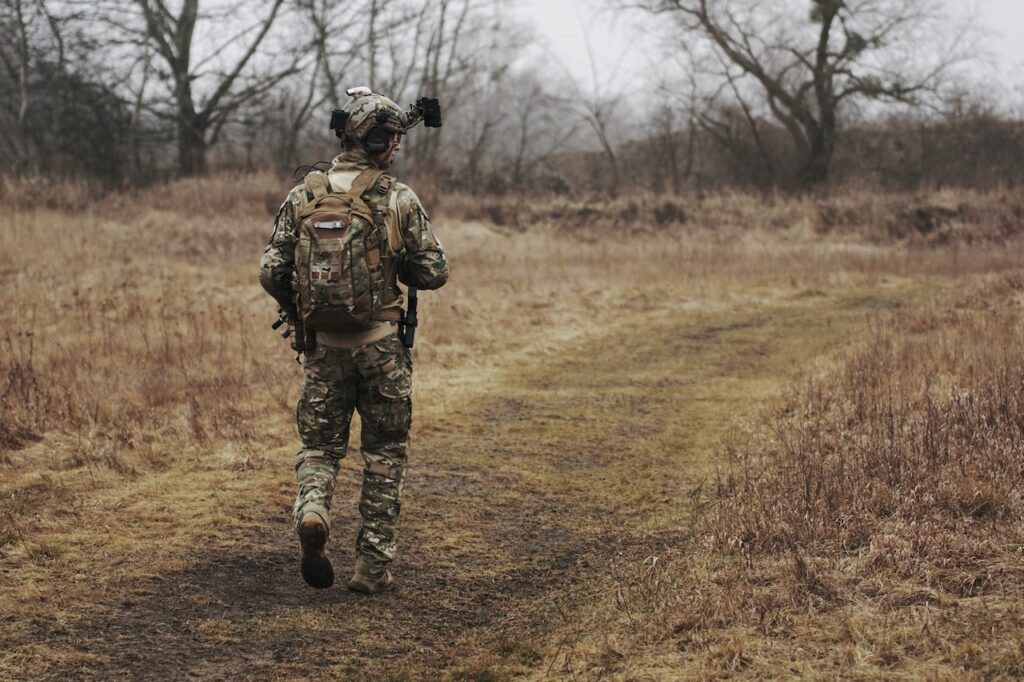Aearo Technologies and 3M Company provided the U.S. military with Combat Arms earplugs from 2003 to 2015. These dual-ended earplugs were designed to give military personnel hearing protection while ensuring they could still hear commands and interact with fellow soldiers. However, there’s evidence that the 3M Combat Arms earplugs had design flaws, potentially leading to hearing loss.
The U.S. military used 3M Combat Arms earplugs to protect service members from hearing impairment and hearing loss, especially those deployed in combat zones like Afghanistan and Iraq between 2003 and 2015. Combat Arms earplugs were standard issue across several military branches, signifying their importance in hearing protection.
With more than 28 million Americans facing hearing loss, military personnel remain particularly vulnerable due to their exposure to loud noise during combat and training.
According to the Hearing Health Foundation, more 1.16 million veterans received VA compensation for hearing damage in 2017, and approximately 1.79 million veterans were compensated for tinnitus.
Aearo Technologies initially created Combat earplugs and secured an exclusive military contract as the main supplier of these ear protection devices from 2003 to 2012. The 3M Company acquired Aearo Technologies in 2008, and subsequently took over the contract.
How Do 3M Combat Arms Earplugs Work?
Like many earplugs, Combat Arms earplugs are designed to be placed in the ear canal, providing hearing protection from loud noise that can cause hearing loss. However, standard ear plugs can sometimes hinder service members from hearing crucial commands or enemy combat.
Aearo Technologies and 3M Company collaboratively created the Combat Arms earplugs with a dual-ended design. This unique combat earplug offers two levels of hearing protection depending on which side is inserted. This ear plug design is identified as a selective attenuation, nonlinear earplug.
The two sides of the combat arms earplug are easily recognized by their distinct colors: yellow and olive.
Inserting the olive end into the ear puts the earplug in the “blocked” position, offering full hearing protection that is similar to traditional earplugs. The yellow side is the “unblocked” setting, allowing military personnel to hear the voices of fellow soldiers, follow commands, and remain alert to the sounds of combat.
What is a Noise Reduction Rating?
The effectiveness of earplugs, including Combat Arms earplugs, is evaluated using a Noise Reduction Rating (NRR). Noise is typically measured in decibels (dBp).
According to the Centers for Disease Control, a regular conversation is roughly 60 decibels, and any noise beyond 120 dBp can lead to immediate hearing loss. For example, a typical gunshot is roughly 140 decibels.
Aearo Technologies told the United States military that the olive side of their dual-ended combat arms earplug offered a 22 decibels Noise Reduction Rating. By contrast, the yellow side had an NRR of 0.
In order to calculate the decibel reduction rate of an ear plug, you need to take its NRR, minus seven, and then divide the results by two. This value, when subtracted from the overall decibel count, provides the new noise exposure level.
Hearing Protection Calculation Example
Let’s use the example of a service member using Combat Arms earplugs with an NRR of 22 exposed to a jet takeoff of 150 dBp.
To calculate the hearing protection level, you would perform the following calculation:
22 – 7 = 15
15 ÷ 2 = 7.5
150 – 7.5 = 142.5
This means that when a soldier is exposed to the takeoff of a jet airplane at 150 decibels while wearing an ear plug with an NRR of 22, the adjusted noise exposure is reduced to 142.5 decibels.
Using an additional layer of hearing protection, like combining earplugs and earmuffs, can increase the NRR. Military regulations say that service members should wear two kinds of hearing protection when they’re exposed to loud noises. Unfortunately, many don’t, saying that it makes them feel isolated from what’s happening around them. It also requires soldiers to turn up their radios or comms, which can defeat the purpose.

3M Combat Arms Earplugs Defects
While Aearo Technologies and 3M Company marketed their Combat Arms earplugs as having a noise reduction rating of 22 for the olive side and 0 for the yellow side, allegations in the Moldex lawsuit highlighted potential defective product issues that could result in lower NRRs. Aearo’s own product testing showed that the actual NRR of the olive side was 10.9, whereas the yellow side had an NRR of -2. An NRR of -2 would enhance sound rather than provide hearing protection.
The earplugs could only achieve the promoted 22 NRR if they snugly fit in the ear canal. However, design flaws prevented the earplugs from fitting properly.
The lawsuit pointed out that the two-sided Combat Arms earplug doesn’t go into is too short to be properly inserted into the ear canal. And when some people try to put it in their ears, part of the earplug pushes against the inside of their ear. It can even fold back into its original shape, meaning it doesn’t create a proper seal.
So, while military personnel believed they had adequate hearing protection, they were inadvertently exposed to the risks of permanent hearing loss and hearing damage from loud noises.
In response to these allegations, 3M agreed to pay a $9.1 million settlement. However, the company did not admit to any wrongdoing in the process.
3M Earplug Lawsuit
On July 26, 2018, in light of allegations related to selling the military defective earplugs, 3M agreed to a settlement of $9.1 million, as stated in a Department of Justice release.
Thousands of veterans filed a 3M Earplug lawsuit due to hearing damage. In a recent update, 3M agreed to settle 250,000 U.S. service members’ claims for $6 billion. This settlement includes $5 billion in cash and an additional $1 billion in 3M company stock, with payouts projected to continue until 2029.
Which Military Branches Used Combat Arms Earplugs?
For more than a decade, Aearo Technologies and 3M maintained an exclusive contract with the United States military. They became the key suppliers of hearing protection, delivering Combat Arms earplugs to countless service members across the Air Force, Army, Marines, and Navy.
In 2012, Moldex introduced its BattlePlugs to soldiers after securing a contract, though 3M kept manufacturing its dual-ended combat arms earplugs until 2015.
Soldiers deployed to Afghanistan under Operation Enduring Freedom were some of the first to use the dual-ended combat arms earplugs. There was an initial hesitancy to use the earplugs, as some army units thought they were too expensive.
However, the importance of hearing protection escalated after commanders recognized its impact on unit performance. By 2004, the Combat Arms earplugs were issued to all soldiers who were deployed, and 3M distributed them across several military bases nationwide.
The U.S. Marine Corps, in particular, held the Combat Arms earplugs in high regards. Their demand skyrocketed in 2003 with orders exceeding 20,000 pairs, putting the product temporarily out of stock.
Fact: By 2004, the United States military provided dual-ended combat arms earplugs to all service members being deployed.

PTSD and Hearing Impairment
U.S. military soldiers often encounter loud noises, and a significant number face noise levels that exceed safe levels.
Combat equipment, like rifles and howitzers, can hit significant noise levels. For example, an M16 can hit 157 decibels, and a howitzer can reach a staggering 183 decibels.
Persistent exposure to these deafening sounds without the proper protection can result in hearing damage and can intensify the symptoms of post traumatic stress disorder (PTSD).
The combined effects of PTSD and hearing impairment can severely impact on the wellbeing of military personnel. A staggering 71% of soldiers coming back from deployments in Iraq and Afghanistan acknowledged their exposure to loud noise, while 15% said they had experienced tinnitus, a hearing impairment characterized by a constant ringing or humming sound in the ears.
These hearing conditions can have severe repercussions on mental health. Veterans suffering from tinnitus are susceptible to depression and anxiety. One study by J. Hu in International Journal of Otolaryngology highlighted that out of 91 veterans with tinnitus, roughly 79.1% suffered from anxiety, 59.3% were dealing with depression, and 58.2% had both.
According to the Department of Defense Hearing Center of Excellence, soldiers are at a higher risk for PTSD when they have hearing problems. Hearing damage can make them feel alone, and the constant ringing associated with tinnitus can be irritating. These issues can exacerbate their stress, sadness, worries, and sleep troubles.
References
- https://3m.com/English/press-releases/press-releases-details/2008/3M-Completes-Acquisition-of-Aearo-Technologies-Inc/default.aspx
- https://www.cdc.gov/nceh/hearing_loss/what_noises_cause_hearing_loss.html
- https://www.courthousenews.com/army-vet-blames-earplug-maker-for-hearing-damage/
- https://www.coopersafety.com/earplugs-noise-reduction
- https://www.docketbird.com/court-documents/United-States-of-America-et-al-v-3m-Company/COMPLAINT-against-3M-Company-Filing-fee-400-receipt-number-0420-6549289-filed-by-Moldex-Metric-Inc/scd-3:2016-cv-01533-00001
- https://www.guns.com/news/2019/01/23/combat-veteran-sues-3m-over-defective-hearing-plugs
- https://health.mil/News/Articles/2018/09/20/Noise-impact-on-hearing-loss
- https://hearing.health.mil/Education/Conditions-and-Concerns/PTSD-and-APD
- https://hearing.health.mil/Resources/Training/Hearing-Loss-Prevention
- https://hearinghealthfoundation.org/veterans
- https://www.justice.gov/opa/pr/3m-company-agrees-pay-91-million-resolve-allegations-it-supplied-united-states-defective-dual
- https://www.militarytimes.com/news/your-military/2019/02/14/hundreds-of-vets-are-suing-over-these-defective-combat-earplugs/
- https://www.ncbi.nlm.nih.gov/pmc/articles/PMC2636536/
- https://www.ncbi.nlm.nih.gov/pmc/articles/PMC4830069/
- https://www.ncbi.nlm.nih.gov/pmc/articles/PMC4918647/
- https://www.ncbi.nlm.nih.gov/pubmed/26697070
- https://www.research.va.gov/topics/hearing.cfm
- https://synergist.aiha.org/201611-noise-limits-for-warfighting
